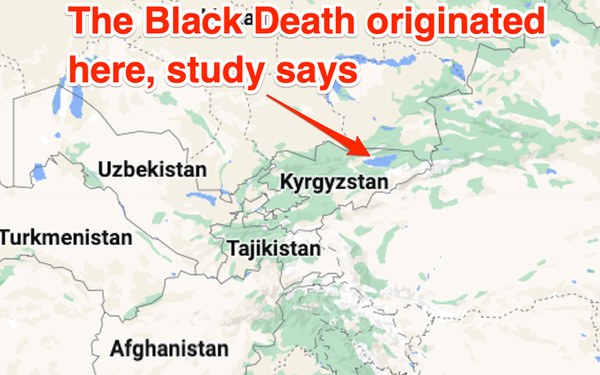The Black Death, the greatest pandemic in human history, was caused by the bacterium Yersinia pestis and lasted in Europe between 1346 and 1353. Despite the pandemic’s enormous demographic and societal impacts, its origins have long been a mystery. Researchers from the Max Planck Institute for Evolutionary Anthropology in Leipzig, the University of Tübingen in Germany, and the University of Stirling in the United Kingdom have now obtained and studied ancient Y. pestis genomes that trace the pandemic’s origins to Central Asia.
Plague first entered the Mediterranean via trade ships transporting goods from the Golden Horde’s territories in the Black Sea in 1347. In a large-scale outbreak known as the Black Death, the disease spread across Europe, the Middle East, and northern Africa, killing up to 60% of the population. This first wave was followed by a 500-year pandemic known as the Second Plague Pandemic, which lasted until the early nineteenth century.
The cause of the Second Plague Pandemic has long been a source of contention. One of the most widely accepted theories places its origins in East Asia, specifically China. On the contrary, the only archaeological finds to date have come from Central Asia, near Lake Issyk Kul in what is now Kyrgyzstan.
We discovered that modern strains most closely related to the ancient strain are now found in plague reservoirs near the Tian Shan mountains, which is very close to where the ancient strain was discovered. This suggests that the Black Death’s ancestor originated in Central Asia.
Johannes Krause
These findings show that an epidemic devastated a local trading community in the years 1338 and 1339. Specifically, excavations that took place almost 140 years ago revealed tombstones indicating that individuals died in those years of an unknown epidemic or “pestilence.” Since their first discovery, the tombstones inscribed in Syriac language, have been a cornerstone of controversy among scholars regarding their relevance to the Black Death of Europe.
An international team of researchers examined ancient DNA from human remains, as well as historical and archaeological data from two sites discovered to contain “pestilence” inscriptions, for this study. The team’s initial findings were promising, as DNA from the plague bacterium, Yersinia pestis, was found in individuals whose tombstones bore the year 1338. “We were finally able to show that the epidemic mentioned on the tombstones was indeed caused by plague,” says Phil Slavin, one of the study’s senior authors and a historian at the University of Sterling in the United Kingdom.

Researchers found the Black Death’s source strain
But could this be the source of the Black Death? Researchers previously linked the outbreak of the Black Death to a massive diversification of plague strains, dubbed the “Big Bang” event of plague diversity. However, the precise date of this event could not be determined, and it was thought to have occurred between the 10th and 14th centuries. The team then pieced together complete ancient plague genomes from Kyrgyzstan sites and investigated how they might be related to the Big Bang event.
“We found that the ancient strains from Kyrgyzstan are positioned exactly at the node of this massive diversification event. In other words, we found the Black Death’s source strain and we even know its exact date [meaning the year 1338],” says Maria Spyrou, lead author and researcher at the University of Tübingen.
But where did this strain come from? Did it evolve locally or did it spread in this region from elsewhere? Plague is not a disease of humans; the bacterium survives within wild rodent populations across the world, in so-called plague reservoirs. Hence, the ancient Central Asian strain that caused the 1338-1339 epidemic around Lake Issyk Kul must have come from one such reservoir.
“We discovered that modern strains most closely related to the ancient strain are now found in plague reservoirs near the Tian Shan mountains, which is very close to where the ancient strain was discovered. This suggests that the Black Death’s ancestor originated in Central Asia” explains Johannes Krause, the study’s senior author and director of the Max Planck Institute for Evolutionary Anthropology.
The study demonstrates how well-defined archaeological contexts, as well as close collaborations among historians, archaeologists, and geneticists, can solve big mysteries from our past, such as the origins of the infamous Black Death, with unprecedented precision.
















